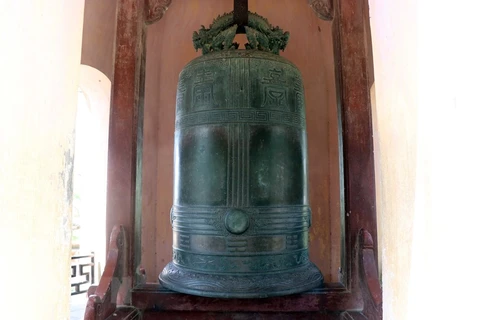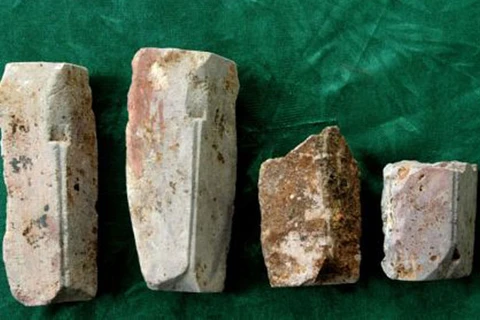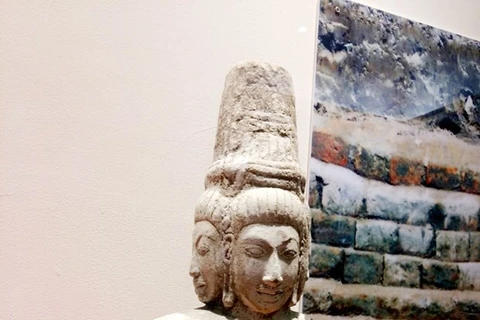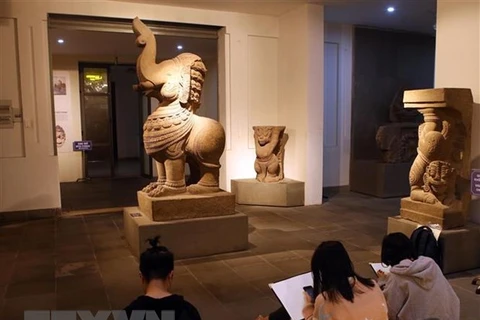 The statues of the Buddhas of the three times (the past, present, and future) at But Thap Pagoda in Dinh To commune of Thuan Thanh district, Bac Ninh province (Photo: VNA)
The statues of the Buddhas of the three times (the past, present, and future) at But Thap Pagoda in Dinh To commune of Thuan Thanh district, Bac Ninh province (Photo: VNA) Hanoi (VNA) – But Thap Pagoda, courtesy name Ninh Phuc Tu, is one of the most beautiful of its kind in the Red River Delta region and home to four groups of national treasures that have been kept almost intact.
The pagoda, located in But Thap hamlet of Dinh To commune in Thuan Thanh district, the northern province of Bac Ninh, was built in the 14th century on an area of about 10,000 square metres. It boasts unique architecture and harmony with the surrounding environment.
Aside from its historical and architectural values, But Thap also boasts four groups of national treasures, including the thousand-hands and thousand-eyes Avalokitesvara statue that was recognised in 2012. The statues of the Buddhas of the three times, the nine-story lotus tower, and the altar earned the recognition in 2020.
All the objects were made from wood in the 17th century.
Nguyen Huu Chien, a guide from the relic management board of Bac Ninh province, said each national treasure has its own unique values, but the most special one is the thousand-hands and thousand-eyes Avalokitesvara statue.
This statue, 3.7 metres in height and 2.1 metres in width, features 46 big arms and more than 900 small hands. It is assessed as a sculptural masterpiece.
Positioned near this statute are the statutes of the Buddhas of the three times: Amitabha - the Buddha of the past, Shakyamuni - the Buddha of the present, and Maitreya - the Buddha of the future. All have kind, serene, and also noble faces.
These statues are considered typical examples of the Buddhist sculpture in the Red River Delta region. They enable viewers to both become closer to the world of Buddhism and admire the beauty of the Buddhist art, which is the uniqueness that cannot be found in any other statutes of the Buddhas of the three times, Chien noted.
In particular, visitors to But Thap Pagoda will be surprised at the beauty of the nine-story lotus tower, which is in an octagonal shape and 7.8 metres tall. The nine stories of this tower, with lotus patterns engraved, reflect the nine religious lives of Lord Buddha and contain hundreds of high relief sculptures of the Buddha, monks, as well as plants and animals, aiming to encourage people to do good actions and steer clear of evil.
 The high reliefs on the nine-story lotus tower at But Thap Pagoda in Dinh To commune of Thuan Thanh district, Bac Ninh province (Photo: VNA)
The high reliefs on the nine-story lotus tower at But Thap Pagoda in Dinh To commune of Thuan Thanh district, Bac Ninh province (Photo: VNA) Chien said the nine-story lotus tower demonstrates typical features of the Vietnamese Buddhism, which closely combines Zen Buddhism, Pure Land Buddhism, and Tantric Buddhism, in the 17th century.
In addition, a number of ancient altars are also kept at But Thap, with the most outstanding being the one placed in the upper hall.
Showing the skills of the artisans who made it, the uniqueness of this altar lies in not only its large size or sophisticated engravings but also the topics of decorations, especially dragon patterns.
But Thap Pagoda is also home to nearly 100 wooden statues in various postures and with vivid facial expressions, along with more than 50 stone relief sculptures depicting animals, flowers, and plants.
With its special values, the pagoda was listed as a national relic site by the Ministry of Culture and Information in 1962 and a special national relic site by the Prime Minister in 2013.
Nguyen Van Dap, head of the cultural heritage management division of the Bac Ninh provincial Department of Culture, Sports and Tourism, said But Thap holds significant values and can be described as a museum of antiquities, most of which remain intact.
The But Thap Pagoda festival takes place on the 23rd and 24th of the third lunar month every year with many traditional cultural activities, which also add to the specialness of this Buddhist relic site./.
























